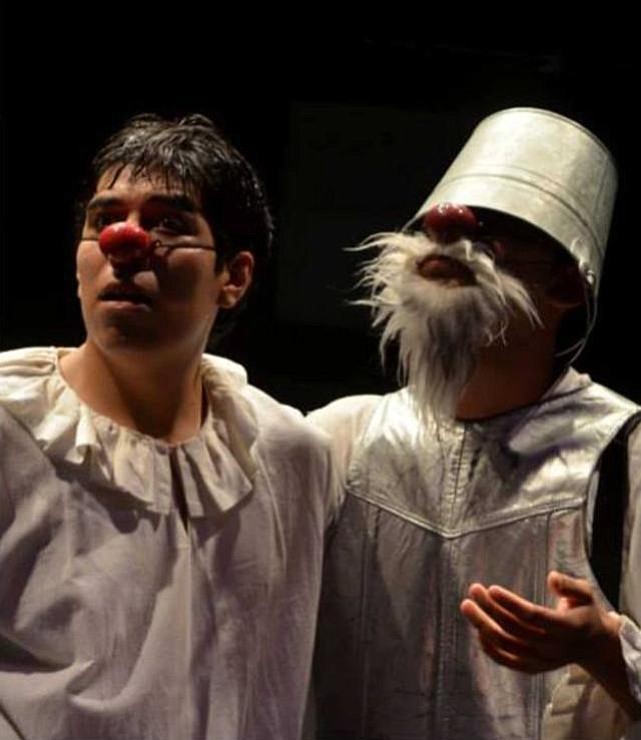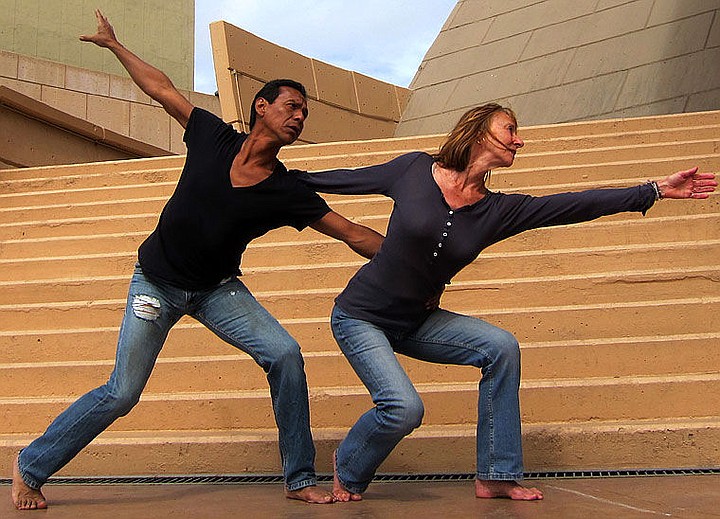 Facebook
Facebook
 X
X
 Instagram
Instagram
 TikTok
TikTok
 Youtube
Youtube

The Other Don Quixote. Three clowns – replete with red noses – represent three after-hours workers at a film studio. The set, like most at the Fringe, is rudimentary, made up of bare bone essentials: a director’s chair, a screen in the center, a table filed with scarves, hats, vests, a clothes rack.
During a break in filming, the three clowns create their own story of Don Quixote with the props at hand.
There is absolutely no dialogue, only wheezing, sneezing, chuckling, spitting. We meet a funny Fat Man, an overall-wearing janitor who falls in love with a mop. The second clown is thin and in high-water pants with shoes that make him literally slip-slide along. The third, a tall, lanky fellow, assumes the role of Camera Man.
Lots of laughter fills the house, as there are plenty of exaggerated facial expressions, zany scenarios, and out-and-out slapstick inanity — they’re like our favorite cartoon characters made flesh. Filmmusik a la Charlie Chaplin enlivens the action.
The thin clown plays Quixote, while the lowly, simple Sancho Panza goes to the pudgy clown. The cameraman records their antics and also stars as Dulcinea.
An ingenious use of strobe lights mimic the shaky nature of 1930s black-and-white films.
“We tell ourselves stories in order to live,” Joan Didion says. For our Fringe version of Don Quixote, ABordo Teatro of Tijuana suggests: “We create diversions to make it bearable.” A heroic and hilarious act. Bring your kids and/or your inner child!

120 Years. This bi-national show combines dance, film, poetry — and a phone call to Mexico — to celebrate the partnership of Betzi Roe (US) and Manuel Alcantara (Mexico). Alcantara cannot perform since his visa was not granted. Dancers are known for their flexibility: here, that term carries extra weight: the missing male role is filled in by the lissome John Diaz.
There are no grand, “dancerly” moves, only simple, pedestrian movements and gestures. The presentation is intimate and humble, like flipping through a photo album with your chum. We do, in fact, look at pictures in film clips, like “120 Years Scrapbook.” The title stands for the sum of the duo’s time spent dancing: 66 for Roe; 54 for Alcantara. The album shows glorious pictures of their younger days, starring in professional companies on both sides of the border.
Roe performs a whimsical dance, “Ode to My Shoes,” inspired by Pablo Neruda’s “Ode to My Socks.”
Roe and Diaz make a short call to Tijuana to share the joy with Alcantara.
The program ends with a film of “What’s Going On Now” — Roe and Alcantara teaching and nurturing a new generation of dancers. Musical accompaniment: U2’s “Song for Someone.”


The Other Don Quixote. Three clowns – replete with red noses – represent three after-hours workers at a film studio. The set, like most at the Fringe, is rudimentary, made up of bare bone essentials: a director’s chair, a screen in the center, a table filed with scarves, hats, vests, a clothes rack.
During a break in filming, the three clowns create their own story of Don Quixote with the props at hand.
There is absolutely no dialogue, only wheezing, sneezing, chuckling, spitting. We meet a funny Fat Man, an overall-wearing janitor who falls in love with a mop. The second clown is thin and in high-water pants with shoes that make him literally slip-slide along. The third, a tall, lanky fellow, assumes the role of Camera Man.
Lots of laughter fills the house, as there are plenty of exaggerated facial expressions, zany scenarios, and out-and-out slapstick inanity — they’re like our favorite cartoon characters made flesh. Filmmusik a la Charlie Chaplin enlivens the action.
The thin clown plays Quixote, while the lowly, simple Sancho Panza goes to the pudgy clown. The cameraman records their antics and also stars as Dulcinea.
An ingenious use of strobe lights mimic the shaky nature of 1930s black-and-white films.
“We tell ourselves stories in order to live,” Joan Didion says. For our Fringe version of Don Quixote, ABordo Teatro of Tijuana suggests: “We create diversions to make it bearable.” A heroic and hilarious act. Bring your kids and/or your inner child!

120 Years. This bi-national show combines dance, film, poetry — and a phone call to Mexico — to celebrate the partnership of Betzi Roe (US) and Manuel Alcantara (Mexico). Alcantara cannot perform since his visa was not granted. Dancers are known for their flexibility: here, that term carries extra weight: the missing male role is filled in by the lissome John Diaz.
There are no grand, “dancerly” moves, only simple, pedestrian movements and gestures. The presentation is intimate and humble, like flipping through a photo album with your chum. We do, in fact, look at pictures in film clips, like “120 Years Scrapbook.” The title stands for the sum of the duo’s time spent dancing: 66 for Roe; 54 for Alcantara. The album shows glorious pictures of their younger days, starring in professional companies on both sides of the border.
Roe performs a whimsical dance, “Ode to My Shoes,” inspired by Pablo Neruda’s “Ode to My Socks.”
Roe and Diaz make a short call to Tijuana to share the joy with Alcantara.
The program ends with a film of “What’s Going On Now” — Roe and Alcantara teaching and nurturing a new generation of dancers. Musical accompaniment: U2’s “Song for Someone.”
Comments